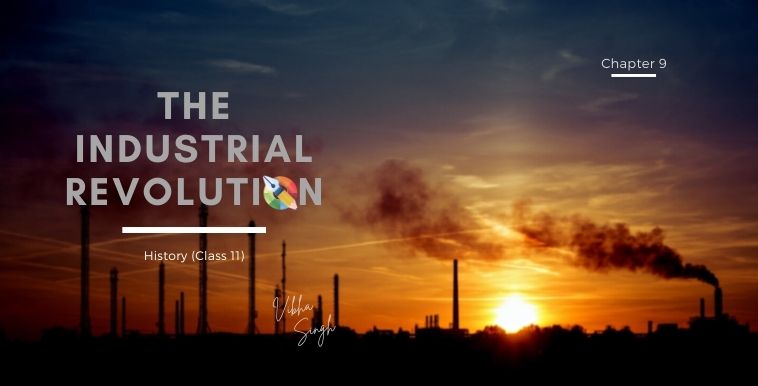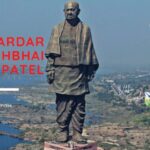This post is the precise notes of NCERT class 11 history chapter 9 Notes by Vibha Maam.
The Industrial Revolution
First industrial revolution occurred in Britain between 1780 and 1850s.The phase of industrial development in Britain is strongly associated with the new machinery and technologies. Steam was used to begin on a wide scale in British industries.
Many of the inventors and businessmen who brought revolution were often neither personally wealthy nor educated in basic science.
Industrialization led the country to prosperity. The term ‘Industrial Revolution’ was used by European scholars- George Michelet in France and Friedrich Engels in Germany.
Why Britain?
England, Wales and Scotland unified as a Britain. It was a monarchy. There were no taxes on goods, that’s why prices of goods were not increasing.
In the 17th century, money was used as a medium of exchange. In18th century agricultural revolution occurred.
Big landowners had brought up small farms near their fields and increased food production. This forced landless farmers to search for jobs in the towns.
Towns, Trade and Finance
Many towns in Europe were growing in area and population from the 18th century. London was the greatest one.
London replaced Amsterdam as the source of loans for international trade. London also became a triangular trade center of England, Africa and West Indies.The offices of trading companies of America and Asia were London.
Good network of rivers and indented (zig-zag) coastline, movement of goods made possible through water transports. water transport was cheaper and faster than other means until the spread of the railway. Cargo was easily transferred to coastal ships(coasters).
The Bank of England (1694) was the main financial system of the country. There were more than 600 banks in the provinces and over 100 banks in London alone. Many poor people from the villages were able to work in towns, whereas banks gave loans money to set up large industries and good transportation. A range of technical changes and construction of railways increased production levels dramatically.
Coal and Iron
- Coal and iron ore was founded in England. However, until the 18th century. There was scarcity of usable iron because charcoal was used for smelting iron. Its impurities produced poor quality iron. It could not generate high temperatures.
- Abraham Darby brought a revolution in the metallurgical industry.
- The invention was a blast furnace that would use coke derived from coal by removing the sulphur and impurities.
- The second Darby developed wrought iron from pig iron. Henry Cort designed the pudding furnace and the rolling mill, which used steam power to roll purified iron into bars. The durability of iron made it a better material than wood.
- John Wilkinson made the first iron chair, vats and distilleries and iron pipes.
- The third Darby built the first iron bridge in the world. For the water supply of Paris, Wilkinson used cast iron for the first time to make water pipes.
- The iron industry then came to be concentrated in specific regions as integrated units of coal mining and iron smelting. Since the coal fields were near the coast, shipbuilding increased.
- The product of the British was the cheapest in Europe; Britain was smelting more iron than the rest of the world put together.
Cotton spinning and Weaving
The British had always woven cloth out of wool and flax. Cotton clothes had been imported from India. After controlling India by East India Company, raw cotton began to be imported which could be spun into cloth in England.
Till the early eighteenth century, spinning had been a slow process but invention of technologies had given the great pace of the cotton industry. This industry had two features which were also seen in other industries. Raw cotton had to be entirely imported and a large part of Britain could retain control over the source of raw cotton as well as the markets.
Steam Power
Water had been the prime source of energy for centuries but it depended on seasons, flow of water, area etc. it was used differently. steam power was the only source of energy to the machinery. Steam power was first used in the mining industry. flooding in mining was a serious problem. Thomas Savery built a model steam engine called the miner’s friend in 1698 to drain mines.
Another steam engine was built by Thomas Newcomen in 1712.
James Watt invented the steam engine in 1769. Watt created the Soho Foundry in Birmingham in 1775. Watt’s steam engine was beginning to replace hydraulic power.
Canals and Railways
- Transportation of coal in industry was slow and expensive through the road.
- Canals were initially built to transport coal to cities.
- The first English canal, the Worsley Cand(1761) made by James Brindley. After completing the canal, coal prices fell by half. Canals were built by big land owners. The city of Birmingham was a confluence of a canal which connected London, the Bristol channel, and the Mersey and Humber rivers.
- From 1788 to 1796, this period was known as the Canal Mania.
- The first steam locomotive, Stephensons Rocket, appeared in 1814. In 1801, Richard Trevithick had devised an engine called the ‘Puffing Devil’ that pulled trucks around mines
- In 1814, George Stephenson constructed a locomotive (called the Blucher), the first railway line connecting the cities of Stockton and Darlington in 1825 at speed 24 kph.
- The second railway line connected Liverpool and Manchester in 1830.
- There were several problems revealed in using the canal. The congestion of vessels, Frost, flood, drought limited the time of their use. The railway now appeared as a convenient alternative.
- During the little railway mania(1833-37) 1400 miles of line was built. and during the’ bigger railway mania'(1844-47) 9,500 miles of line was built. Most of England had been connected by Railways by 1850.
Who were the inventors?
- Dozens of scientific journals and published papers of scientific societies appeared in England between 1760 & 1800.
- Education was extremely limited until the late 19th century. This was met by the activities of the society of Arts(1754) by traveling lectures,or in coffee houses that multiplied through the 18th century.
- Most inventions were more the product of determination, interest, curiosity,even luck than the application of scientific knowledge and they had tremendous power of memory, imagination and concentration.
- Johnkay and James Hargreay were carpenters, Richard Arkwright was a barber,Samuel Crompton and Edmund Cartwright studied literature and agriculture.
- Thomas Savery (inventor of steam engine) was an army officer. Thomas Newcomen was a black smith, James Watt was a mechanical bent.
- All had some knowledge relevant to their inventions. John Metcalf (the road builder) was blind. James Brindley (Canal builder) was illiterate.
Changed lives
There would be revolutionary changes in society. Similarly, rich individuals invested money in industries in the hope that their money would multiply. wealth, income service, knowledge and productivity efficiency did increase dramatically.
The Workers
A survey in 1842 revealed that the average lifespan of workers was lower than other social groups in the cities. It was 15 years in Birmingham,17 in Manchester, 21 in Darby. half the children fail to survive beyond the age of 5.
Deaths were primarily caused by epidemics, water pollution (cholera, typhoid) air pollution (tuberculosis).
Women, Children and Industrialisation
- Children and women who had worked at home under the supervision of a guardian, had reached the factories after the industrial revolution. They had to work long hours under strict discipline, harsh punishment and meager wages.
- Industrialist prefer to employ women and children who would be less agitated than that of men. They were employed in large numbers in the cotton textile industries in Lancashire and Yorkshire. Women mainly work in the silk, Lace-making and knitting industries as well as in the metal industries of Birmingham.
- Children were often employed in textile factories because they were small enough to move between tightly packed machinery. Sometime due to exhaustion, they fell into machines and died.
- Coal mines were also dangerous places to work in. Explosions in mines were common. The owners used children to reach deep in mine where the approach path was too narrow for adults.
- Young children worked as ‘trappers’ who opened and shut the door for coal wagons, and as ‘coal bearers‘ who carried heavy loads of coal on their back.
Protest Movements
The ‘French Revolution‘ showed the possibilities of collective mass action for liberty, equality and fraternity. In England, political protest against the harsh working conditions in factories and to be given the right to vote for workers kept increasing.
The government smashed these protests by suppression and by new laws. In 1795, parliament passed two Combination Act which made it illegal to incite the people by speech or criticize the government, banned people’s meetings but protest continued against the ‘old corruptions’ (privileges to the monarchy and nobles). Members of parliament were opposed to giving the right to vote to the workers. They supported the Corn Law, which prevented the import of cheaper food. Workers expressed their anger and frustration in numerous forms of protests. Throughout the country from the 1790 onwards until the 1840s.
Another cause of hardship was the process known as ‘enclosure’ -by which, from the 1770’s, hundreds of small farmers had been merged into the larger ones of powerful landlords.
Introduction of machines worst affected the weavers’ life. From the 1790s, these weavers began to demand a legal minimum wages; which was refused by parliament. Weavers destroyed the power looms. protests also took place in the woolen knitting industry in Nottingham, Leicestershire and Derbyshire. In the riots of 1830, farm labourers smashed the threshing machines. they had been punished brutally.
The Luddism movement
The Luddism movement (1811-17) led by the Charismatic General Ned Ludd. its participants demanded a minimum wage, control over the labour of women and children, work for those who had lost their jobs due to machines and the right to form trade unions.
August 1819, 80,000 people gathered peacefully at Saint Peter’s field in Manchester to claim democratic rights. they were suppressed brutally. This suppression has been known as the Peterloo massacre. Their demands were refused by the Six Act but there were some gains. After Peterloo, House of commons was recognised by liberal political groups and the Combination Acts were repealed in 1824-25.
Reforms through Laws
Laws were passed in 1819, prohibiting the employment of children under the age of 9 and limiting the hours of work to 12 hours a day. In 1833 an Act was passed that permitted children under 9 to be employed only in silk factories. After a long agitation,in 1847, the ‘Ten Hours ‘ Bill was passed for all male and female workers. The Mines and Collieries Act of 1842 banned children under 10 and women from working underground. Field’s factory Act laid down in 1847 for 10 hours work a day.
The Debate on the Industrial Revolution
Industrial revolution occurred in Britain from the 1780s to the 1820s. Industrialization is associated with a growing investment of the country’s wealth in capital formation of buildings, infrastructure and installing new machinery. The cotton, iron and engineering industries had accounted for less than half of industrial output until the 1840s. Historians have pointed to the fact that from 1760 to 1815,Britain tried to do two things simultaneously – to industrialize and to fight wars in Europe, North America and India. Britain was at war for 36 out of 60 years from 1760. Britain had to use borrowed money in war rather than investment. Workers were transferred out of factories and farms to the army.
The transformation extended beyond the economy and industry and into society and gave prominence to two classes:
- The bourgeoisie (the capitalist class of third estate) and
- The proletarian (wage earning, the lowest class of society) labourers in towns and in the countryside.
Share this note with your friends and classmates and also comment in the comment section below.
For Novels and books at affordable price you can checkout Checkfirst
Stay tuned for more amazing post & articles like this.









Love this web site